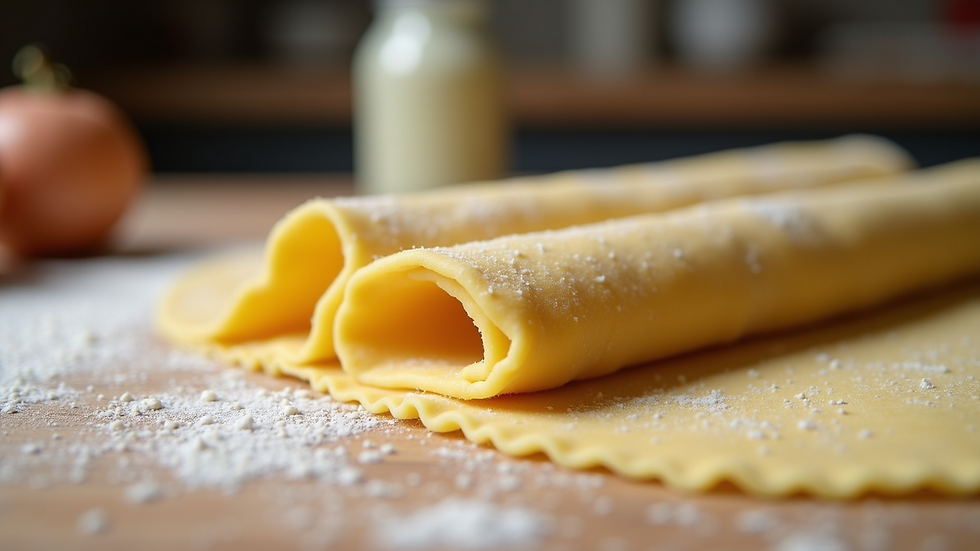The Craft Behind Traditional Pasta-Making Techniques
- IFM GOURMET RETAIL
- Aug 13
- 4 min read
Updated: Aug 28
Pasta is more than just a staple food; it is a symbol of culture, tradition, and craftsmanship. The art of making pasta by hand has been passed down through generations, preserving techniques that bring out the best flavors and textures. Traditional pasta-making is a meticulous process that requires patience, skill, and an understanding of ingredients. This post explores the craft behind traditional pasta-making techniques, highlighting the methods, tools, and unique qualities that make handmade pasta so special.
Collection of brinze die pasta Poseidon Emporium
The Essence of Traditional Pasta-Making
Traditional pasta-making starts with simple ingredients: flour, water, and sometimes eggs. The quality of these ingredients is crucial. For example, durum wheat semolina flour is preferred for its high protein content and ability to create firm pasta. The process begins by mixing the flour and water to form a dough, which is then kneaded until smooth and elastic.
Kneading is an essential step that develops gluten, giving pasta its structure and chewiness. After kneading, the dough rests to allow the gluten to relax, making it easier to roll out. Rolling the dough thinly by hand or with a rolling pin is a skill that requires practice to achieve the perfect thickness without tearing.
Once rolled, the dough is cut into various shapes depending on the type of pasta desired. Shapes like tagliatelle, fettuccine, and pappardelle are common in traditional Italian cuisine. Each shape has a purpose, pairing well with specific sauces and cooking methods.

Traditional Pasta Tools and Techniques
The tools used in traditional pasta-making are simple but effective. A wooden board or marble slab is often used for kneading and rolling the dough. A rolling pin helps achieve the desired thinness, while knives or special cutters shape the pasta.
One traditional technique is the use of a pasta machine, which helps roll and cut dough evenly. However, many artisans prefer hand-rolling to maintain control over thickness and texture. The hand-rolled method also allows for slight variations that give handmade pasta its unique character.
Drying pasta is another important step. Traditionally, pasta is hung on wooden racks or laid flat on cloths to dry slowly. This prevents the pasta from sticking and helps it maintain its shape during cooking.
What pasta is bronze-cut?
Bronze-cut pasta is a traditional method where pasta dough is extruded through bronze dies instead of Teflon or other modern materials. This technique creates a rougher surface on the pasta, which helps sauces cling better, enhancing the overall flavor experience.
The rough texture of bronze-cut pasta is highly prized by chefs and pasta lovers alike. It allows the pasta to absorb sauces more effectively, making every bite rich and satisfying. This method is often used for shapes like penne, rigatoni, and fusilli.
The Role of Regional Variations in Traditional Pasta
Italy alone boasts hundreds of pasta varieties, each tied to a specific region and its culinary traditions. For example, in Naples, pasta is often made with water and flour only, resulting in a lighter texture. In contrast, northern regions like Emilia-Romagna use eggs in their dough, producing richer pasta.
Shapes also vary by region. Orecchiette, small ear-shaped pasta, is typical of Puglia, while trofie, twisted pasta, is common in Liguria. These regional differences reflect local ingredients, climate, and cultural influences.
Understanding these variations helps appreciate the diversity and depth of traditional pasta-making. It also encourages experimentation with recipes and techniques to create authentic dishes.
Tips for Making Traditional Pasta at Home
Making traditional pasta at home can be a rewarding experience. Here are some practical tips to get started:
Use high-quality flour - Durum wheat semolina or 00 flour works best.
Measure ingredients accurately - Pasta dough is sensitive to moisture levels.
Knead thoroughly - Aim for a smooth, elastic dough.
Let the dough rest - At least 30 minutes to relax gluten.
Roll thinly and evenly - Use a rolling pin or pasta machine.
Cut shapes carefully - Use sharp knives or cutters.
Dry pasta properly - Hang or lay flat to avoid sticking.
Cook in plenty of salted water - Fresh pasta cooks quickly, usually 2-4 minutes.
By following these steps, you can create pasta that rivals traditional handmade varieties.
Embracing the Tradition in Modern Kitchens
While modern technology has introduced convenience to pasta-making, embracing traditional techniques offers a deeper connection to the food and its history. Handmade pasta carries a texture and flavor that machines cannot replicate fully.
Experimenting with traditional methods also allows for creativity. You can try different flours, shapes, and sauces to find your perfect combination. Sharing the process with family or friends can turn pasta-making into a joyful and educational activity.
Incorporating traditional pasta into your cooking repertoire enriches your meals and honors a timeless culinary art.
Traditional pasta-making is a craft that combines simple ingredients with skilled techniques to create something truly special. Whether you are a beginner or an experienced cook, exploring these methods can deepen your appreciation for pasta and inspire delicious homemade meals.






Comments